Back in 2019, the year before the pandemic, many of you will have seen images of long ‘trains’ composed of up to sixty SpaceX Starlink satellites crossing the sky in a straight line. These pictures hit the headlines not only because of the number of satellites, but because of their brightness.
A ‘train’ of SpaceX Starlink satellites, the satellites are around 300 km in altitude. In the days after launch these trains break up as the satellites position themselves into their final orbits at around 550 km altitude.
Since 2019, these have been launched in batches of up to sixty satellites at a time and their purpose is to provide worldwide fast internet coverage. Prior to Starlink, the only companies offering satellite internet were providers such as Viasat and HughesNet which have a small number of satellites in geostationary orbit (GEO), 35 800 km above the Earth’s surface. This limits response times, coverage and bandwidth. It takes around 0.12 seconds for radio-waves to travel between a geostationary satellite and the Earth.
SpaceX’s plan is to surround the Earth with a large number of satellites in Low Earth Orbit (LEO). This offers much better response times and greater capacity than GEO satellites networks. The plan is that the network of Starlink satellites will grow over the next few years forming a ‘floating internet backbone’, providing a more flexible alternative to the fibreoptic cables that span the world.

At time of writing this post, SpaceX have launched 6613 Starlink satellites, 6159 of these satellites are still in orbit. (Most of the satellites launched in 2019 were test satellites which have been intentionally deorbited.) SpaceX have been given approval by the U.S. Federal Communications Commission (FCC) to launch up to 12000 satellites and are seeking permission to put an additional 30 000 Starlink satellites into orbit.
To put these numbers into perspective, in the 66 years from the launch of Sputnik-1 in October 1957 to December 2023 nearly 17 000 satellites had been placed into Earth orbit by ALL nations, of which 11500 were still in space. In December 2023 40% of satellites in Earth Orbit were SpaceX Starlinks!
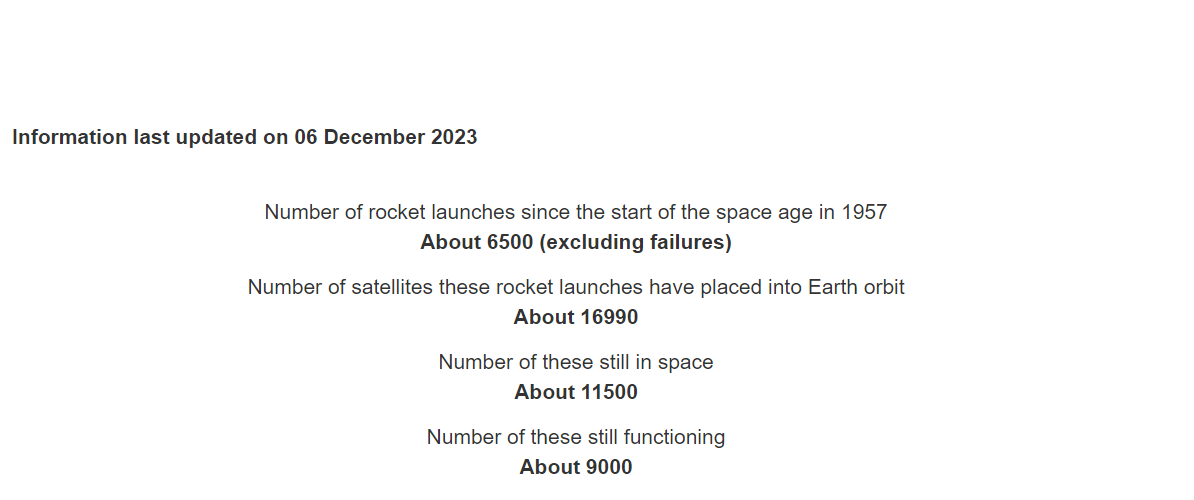
Source ESA
Other Operators
High speed satellite broadband is likely to be a big growth area in the future, because it offers access to internet without need for an expensive fixed line infrastructure, which can be difficult and very costly to build in remote areas. By 2040, it may be worth in excess of 400 billion dollars per annum. So, it is not surprising that other companies are planning similar large LEO satellite constellations. Although none of these companies seem to have plans as ambitious as SpaceX or have launched as many satellites.
Other Operators include
Eutelsat OneWeb
Eutelsat OneWeb are partially owned by the UK government. They have built an initial constellation of 634 satellites, which may be expanded as demand for their service grows.
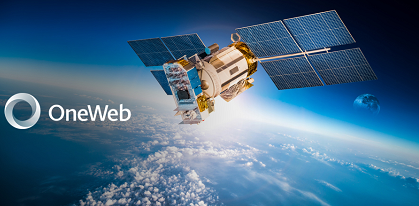
Unlike SpaceX Starlink, OneWeb are aiming their service to businesses, governments departments, phone network operators and other organisations rather then individual consumers.
Amazon – Project Kuiper
Amazon plan to launch a constellation of 3236 satellites. A development known as project Kuiper. As yet no satellites have been launched, the first launches are planned later this year (2024). So they are about four years behind SpaceX, but they intend to be a big player in a growing market and Amazon have massive financial muscle. In terms of turnover Amazon is one of the largest companies on our planet (2023 revenue was $570 billion) and in 2020 it was reported that Amazon would invest $10 billion in Project Kuiper.

Telesat
The Canadian company Telesat have a constellation of 298 LEO satellite, which it plans to expand to around 1700 satellites in the near future.

Impact on astronomy
There has been much written in the press in the last few years about the impact of these satellite constellations on astronomy (not all of these reports have been accurate). Compared to astronomical objects and satellites in higher orbits, LEO Satellites move rapidly across the sky and are in general brighter than other satellites because they are closer to Earth.
However LEO satellites spend most of the night in the Earth’s shadow and are only visible in the twilight hours. This is described further in the video at the end of this post.
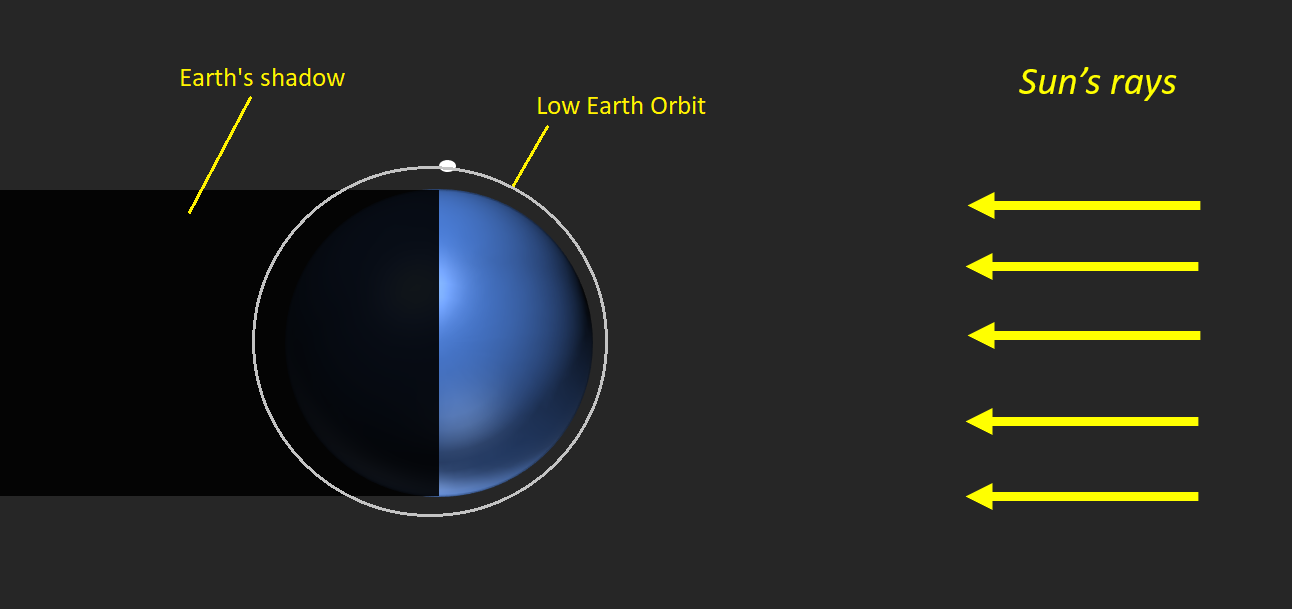
A satellite in a Low Earth orbit will spent roughly half of its orbit in the Earth’s shadow when it will be invisible to an observer because it is not illuminated by the Sun
Space X have been engaging with the astronomical community to reduce the brightness of the Starlink satellites. The long trains of satellites seen just after launch are a temporary formation, which break up as the satellites disperse and move to their higher orbits 550 km above the Earth. All Starlink satellites launched since August 2020 have a visor fitted which reduces the amount of sunlight reflected back to Earth by a factor of three. A recent study found that the average magnitude of Starlink satellite fitted with the visor was +5.92 – making them only just visible to the naked eye, when viewed by someone with good eyesight at a location without significant light pollution.
In raw astronomical images satellites are sometimes captured when they move across a telescope’s field of view. They appear as streaks, looking a little like meteor trails. However, image processing software used by astronomers (including amateurs) can identify satellite tracks and strip them out of the final images.
This might present more of an issue if the number of LEO satellites were to increase rapidly in the next 15 years. Rather than an image containing a single satellite trail, a typical image taken in the twilight hours would contain multiple trails, as numerous satellites crossed the field of view.
The large telescope being constructed at the Vera Rubin observatory may be particularly badly affected. It has an 8.4 metre primary mirror (giving it a very high sensitivity) and also a very large detector giving it a very large of view – so many satellites will be captured in its images. This is a topic I discussed in a previous post.
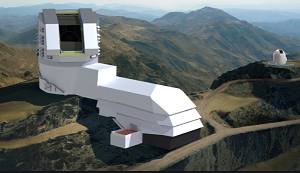
Impact on radio astronomy
Radio astronomy is allocated protected bands in which radio transmitters, including those on satellites, are forbidden to operate. Examples of protected bands are
- the region around 1.420 MHz known as ‘the 21-cm hydrogen line’
- the region around 1.660 GHz the OH-line
- the region around 22.235 GHz, which is a frequency at which interstellar water vapour clouds emit radio waves.
However, radio astronomers sometimes take observations outside the protected bands. They can do this because large radio telescope are often situated in radio quiet zones, often in remote areas, where there is very low quantity of manmade radio transmissions. If, in the coming decades, there are tens of thousands of LEO satellites beaming powerful radio transmission at all locations on Earth, then in future there may be no radio quiet zones anywhere and many frequencies outside the protected bands will be closed to radio astronomy. This is a topic about which I could write a great deal about but, in the interests of keeping this post to a reasonable length ;-), I’ll leave it to Tony Beasley, director of the National Radio Astronomy Observatory, who said in 2020.
SpaceX is legally transmitting inside one of their [allocated] bands and there are going to be impacts for anyone trying to do radio astronomy,” ….”These spectrum allocations represent the goals and intent of society. We make [them] to enable commerce and to enable defense and all kinds of activities. We have to come to a solution that satisfies all these to some extent
And Finally……
It will be interesting to see how things develop over the next decade and how big the impact on ground-based astronomy turns out to be.. What is clear to me is that satellite broadband is likely to become more and more important over the next decade.
For those of you who want a little more information I have made this video which expands some of these topics further

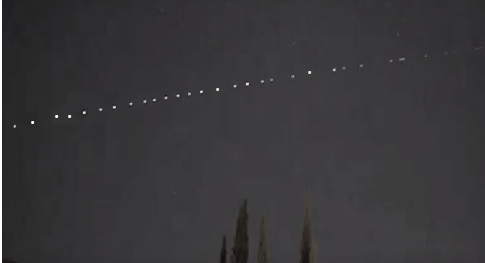
I was out recently with 15x binoculars looking for a particular dim object. I found it interesting how many faint satellites passed through my view once my eyes got adapted.
LikeLike
Yes and of course the numbers of these is increasing all the time
LikeLike
I have to admit, Steve, that despite my annoyance that billionaires are taking over outer space for corporate financial gain, I have had none of my recent astro-images destroyed by satellite trails. The imaging control software has so far coped with this menace!
LikeLiked by 1 person
Yes many people have said the same to me.
Developments such as stacking and the imaging processing software being to identify and remove satellite tracks means that it is not such a big issue as many feared
LikeLike
I am afraid that without proper quality control these constellations sooner or later will get the nickname “Taurus”.
LikeLike
🙂
LikeLike